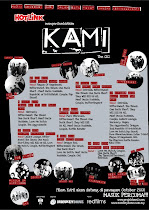
This is my blog. I have written about 2 days ago. Hehe. It is true guys. I have delete my old blog in the early morning. That time I am so dizzy after had a journey from Ipoh to Kangar. I will explain about my profile. Not at all. My name is Muhammad Firdaus Bin Noor Azmi. I born at Ipoh. I have 5 siblings and good parents that had take care of me for a long time. I am quiet shy. I like to make something to become simple. I admire with photographer job. I will use PTPTN money to buy my dream camera. This hobbies make me relax and can feel the unique of Allah S.W.T creations. I love music. Now, Independent or underground music is famous in Malaysia. To know about that, read it in this blog.
Tuesday, October 7, 2008
Posted by Firdaus at 7:09 PM 0 comments
KAMI The Series follows the individual stories of a group of five friends and the events that lead them to find each other.As they each deal with their personal conflict, they learn that they are all on the same road to self-discovery and can no longer avoid coming to terms with self-doubt, relationships, parental pressures and the angst of living the banalities of life in the suburbs.With the future of adult responsibilities closing in on them, the five friends take comfort in the one thing they can count on – their friendship – and music to define the most confusing time of their lives – the teenage years.
Posted by Firdaus at 3:24 AM 0 comments
The first camera that was small and portable enough to be practical for photography was built by Johann Zahn in 1685, though it would be almost 150 years before technology caught up to the point where this was practical. Early photographic cameras were essentially similar to Zahn's model, though usually with the addition of sliding boxes for focusing. Before each exposure, a sensitized plate would be inserted in front of the viewing screen to record the image. Jacques Daguerre's popular daguerreotype process utilized copper plates, while the collotype process invented by William Fox Talbot recorded images on paper.
The first permanent colour photograph, taken by James Clerk Maxwell in 1861.
The first permanent photograph was made in 1826 by Joseph Nicéphore Niépce using a sliding wooden box camera made by Charles and Vincent Chevalier in Paris. Niépce built on a discovery by Johann Heinrich Schultz (1724): a silver and chalk mixture darkens under exposure to light. However, while this was the birth of photography, the camera itself can be traced back much further. Before the invention of photography, there was no way to preserve the images produced by these cameras apart from manually tracing them.
The development of the collodion wet plate process by Frederick Scott Archer in 1850 cut exposure times dramatically, but required photographers to prepare and develop their glass plates on the spot, usually in a mobile darkroom. Despite their complexity, the wet-plate ambrotype and tintype processes were in widespread use in the latter half of the 19th century. Wet plate cameras were little different from previous designs, though there were some models, such as the sophisticated Dubroni of 1864, where the sensitizing and developing of the plates could be carried out inside the camera itself rather than in a separate darkroom. Other cameras were fitted with multiple lenses for making cartes de visite. It was during the wet plate era that the use of bellows for focusing became widespread.
The first colour photograph was made by Scottish physicist James Clerk Maxwell, with the help of English inventor and photographer Thomas Sutton, in 1861.
Posted by Firdaus at 3:10 AM 0 comments

Many early professional SLR cameras, such as the NC2000 and the Kodak DCS series, were developed from 35 mm film cameras. The technology of the time, however, meant that rather than being a digital "back" the body was mounted on a large and blocky digital unit, often bigger than the camera portion itself. These were factory built cameras, however, not aftermarket conversions.
A notable exception was a device called the EFS-1, which was developed by Silicon Film from c. 1998–2001. It was intended to insert into a film camera in the place of film, giving the camera a 1.3 MP resolution and a capacity of 24 shots. Units were demonstrated, and in 2002 the company was developing the EFS-10, a 10 MP device that was more a true digital back.
A few 35 mm cameras have had digital backs made by their manufacturer, Leica being a notable example. Medium format and large format cameras (those using film stock greater than 35 mm), have a low unit production, and typical digital backs for them cost over $10,000. These cameras also tend to be highly modular, with handgrips, film backs, winders, and lenses available separately to fit various needs.
The very large sensor these backs use leads to enormous image sizes. The largest in early 2006 is the Phase One's P45 39 MP imageback, creating a single TIFF image of size up to 224.6 MB. Medium format digitals are geared more towards studio and portrait photography than their smaller DSLR counterparts, the ISO speed in particular tends to have a maximum of 400, versus 6400 for some DSLR cameras.
Posted by Firdaus at 3:05 AM 0 comments
Cameras may work with the light of the visible spectrum or with other portions of the electromagnetic spectrum. A camera generally consists of an enclosed hollow with an opening (aperture) at one end for light to enter, and a recording or viewing surface for capturing the light at the other end. A majority of cameras have a lens positioned in front of the camera's opening to gather the incoming light and focus all or part of the image on the recording surface. The diameter of the aperture is often controlled by a diaphragm mechanism, but some cameras have a fixed-size aperture.
Posted by Firdaus at 2:27 AM 0 comments
 Independent labels have a long history of promoting developments in popular music, stretching back to the post-war period in the United States, with labels such as Sun Records.
Independent labels have a long history of promoting developments in popular music, stretching back to the post-war period in the United States, with labels such as Sun Records.
In the United Kingdom during the 1950s and 1960s, the major record companies had so much power that independent labels struggled to become established. Several British producers and artists launched independent labels as outlets for their work and artists they liked, but the majority failed as commercial ventures or was swallowed up by the majors.
The punk rock era saw a plethora of independent labels. The UK Indie Chart, was first compiled in 1980, and independent distribution became better organized from the late 1970s onwards.
Posted by Firdaus at 2:19 AM 0 comments
The Indie Music Revolution in Malaysia
There's quite a lot being written about this whole 'indie music revolution' currently taking place in Malaysia. From bloggers to newspaper writers, everyone's saying their piece. I'm not in the business of predicting which bands/acts will make it big this year or next year, so this piece will avoid all that. What I'm interested in is why it's taking place now, and not 2 years ago, and not next year.
If you ask me, I think it's a combination of a lot of things. People always say that a country's progress is always reflected by its arts scene. And I'm sure it's no mere coincidence that this whole indie revolution is happening just as the Malaysian political landscape is experiencing its own seismic shift in its make-up. In fact, one would have to be very naive to not want to draw parallels between the two.
For my money, this whole shift is a direct result of us everyday people having more options when it comes to access to information, thanks to increased easy access to the world wide web. Politics-wise we people have far more places to go to when it comes to getting our news. The mainstream newspapers/television/radio no longer have a monopoly on the opinions of us everyday people.
By that same analogy, us everyday music loving kids no longer have to depend on mainstream radio/television to tell us who to listen to or to like. There's Myspace, iMeem, Last FM and all sorts of social networking sites and file sharing sites where us kids can simply discover all sorts of music.
However, easy access alone is no cause for a revolution. Discontent is. For far too long we've been bombarded by average, unremarkable music, pushed down our throats through the radio & TV by the record companies in Malaysia. Full of A&R people who have totally lost touch with what the kids want from Malaysian acts, they stubbornly refuse to mix in with the grass roots and instead try to clone whatever Indonesian acts that make it big over here. People talk about how A&R people should have their finger on the pulse of the music scene. I doubt they even have that finger, let alone know where that pulse is.
We keep on hearing complaints by music industry people of how harmful this 'Indonesian invasion' is, but it's a problem they create themselves. Isn't it obvious by how successful the Indonesian bands are here that the public wants something fresh and different? Isn't it very obvious that Dewa, Sheila On 7, Padi, Peter Pan, Samsons and Nidji are obviously very different and obviously fresher-sounding than Search, Wings, Jinbara, Amuk, Spider, New Boys and the like? But why keep on pushing more rock kangkang and rock leleh Malaysian bands down our throats when it's so obvious that the public wants something else?
And no, don't tell me that there are no Malaysian bands that have that 'fresh' sound. Even before this whole indie music revolution we already have OAG, The Times and to a lesser extent Exists doing their own thing singing in Malay. Butterfingers also came up with a Malay album that's as un-rock kangkang and un-leleh as they come. With the exception of OAG and Exists, radio support for our own 'new school' bands are almost non-existent. So, it's not just the labels but also the radio that has to take their fair share of the blame.
What about the local awards like the AIM? Why is it that year after year, the nominees and winners never seem to involve this whole 'new school' Malaysian bands? The answer is simple, to enter your album to be considered for nomination in the AIM, one has to be a member of RIM first, and that my friends involve membership fees that are quite prohibitive (around RM3000, if I'm not mistaken) if you're an unsigned, struggling indie band. So in reality what the AIM does reflect is that portion of the Malaysian music industry that can afford to pay the RIM membership fees, which probably explains why the more 'urban' (i.e. more affluent) acts are the ones who usually get nominated and win. Which will also explain why non-urban acts like my band Couple will probably never ever get an AIM nomination. Hehehe.
And then there's the TV series Kami, and the meteoric rise of Meet Uncle Hussein and most importantly, Hujan. This small TV series and these 2 small bands basically destroyed all the safeguards and barriers previously put up by the major label cartel and the mainstream media in Malaysia. What basically happened was that a lot of denials and pride had to be swallowed, as these 3 phenomenons, no matter how 'budaya barat' they are (as the elders and the mainstream will always say whenever they don't understand something), are just too important and too big to be ignored. Ignore them and risk losing out on a lot of potential profits. Being the capitalists they are, of course the industry will embrace them.
All of the above factors might be small, but at the end of the day they do add up. Hence the discontent. Not just among the musicians/bands, but also among the listening public. There's only so much crap you can take before you finally say enough is enough, right? And if you ask me, that's exactly what's happened here in Malaysia. The last general election results powerfully demonstrated that a lot of us Malaysians have said exactly that, enough is enough.
And this whole indie music revolution currently happening in Malaysia is also that, kids finally saying enough is enough. Kids slowly making their voices heard loud and clear. They're saying this is what we want. These are the bands we like. You media people might want to push such and such bands as the next big things, but we know better what we want and what we like. The days of the media trying to push their friends' bands as 'geniuses' or next big things will very soon be over, if not over already. The kids now have far more options to choose from. And choose they will. Ah, how beautiful that is, democracy!
Posted by Firdaus at 2:16 AM 0 comments






















